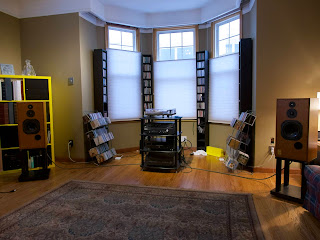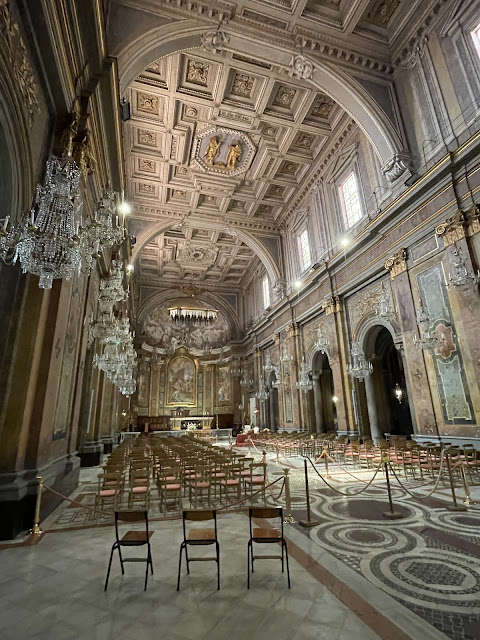On Holidays Classical Music Rocks
I have just come back from a short week in the Netherlands holidaying with a long-time priest friend of mine whom I have known since seminary days. Being alone in the parish I have missed the engaged conversations on theology, philosophy, history, literature and the social sciences that I have got to enjoy and benefit from in the past.
Thankfully too, we both enjoy art and music. I stretched my holiday companion a bit by buying tickets to hear the Dutch Radio Orchestra at the principal classical music venue in Amsterdam, the Concertgebouw. There was a time about 20 years ago when Royal Concertgebouw Orchestra was at the very top of its game. I have quite a few recordings from that period.
What is still very much true, however, is that the hall is still one of the best in the world. Compared to what we are used to in Toronto it is extremely lively. Roy Thomson Hall, by comparison, is so cavernous that sound floats away and loses power and clarity.
The timpani vibrated the floor! The brass cleared out your ears! And the two harps floated ethereally through the space! It was a program of Russian music played with vigour and subtlety too! And compared to what we pay for classical concerts it was very reasonable, about 45 Euro a ticket. That's maybe $65 Canadian. It even included water or juice at the intermission. I was assured by a local that the tickets for the major orchestra are much more expensive, in the 100 Euro neighbourhood, still cheap compared to a rock concert or an NHL hockey game.
The room is more box-shaped with a lower ceiling than we have and many fewer seats, I'm guessing in the 2,000 neighbourhood, that's about 1,000 less than we have in Toronto. I wonder what Massey Hall will sound like when the renovations there are finished? It has always looked tired throughout my 59 years, so I'm sure it will be greatly improved. Sonically, it is likely to better Roy Thomson.
The stage at the Concertgebouw is also at least a foot higher relative to the front row of seats than in Toronto and the seating for the orchestra is much more raked, with each row of musicians raised what looked like 9 or 10 inches above the row below. This gave room for each instrument to go directly out into the air. I suspect that contributed something significant to the clarity of the sound.
The two big pieces were a violin concerto of Tchaikovsky and the famous Pictures at an Exhibition by Modest Mussorgsky orchestrated by the great French composer Maurice Ravel. For the first time I heard clearly the two musical influences in dialogue: the great Russian romantic tradition and the tonal blending (chromaticism) that characterized French music in the first part of the 20th century. The piece was originally scored for solo piano, but has been popular in this orchestration by Ravel ever since it first appeared. It "paints" various pictures throughout its movements, with the crashing and exciting "Great Gate of Kiev" at the end.
Thankfully too, we both enjoy art and music. I stretched my holiday companion a bit by buying tickets to hear the Dutch Radio Orchestra at the principal classical music venue in Amsterdam, the Concertgebouw. There was a time about 20 years ago when Royal Concertgebouw Orchestra was at the very top of its game. I have quite a few recordings from that period.
What is still very much true, however, is that the hall is still one of the best in the world. Compared to what we are used to in Toronto it is extremely lively. Roy Thomson Hall, by comparison, is so cavernous that sound floats away and loses power and clarity.
The timpani vibrated the floor! The brass cleared out your ears! And the two harps floated ethereally through the space! It was a program of Russian music played with vigour and subtlety too! And compared to what we pay for classical concerts it was very reasonable, about 45 Euro a ticket. That's maybe $65 Canadian. It even included water or juice at the intermission. I was assured by a local that the tickets for the major orchestra are much more expensive, in the 100 Euro neighbourhood, still cheap compared to a rock concert or an NHL hockey game.
The room is more box-shaped with a lower ceiling than we have and many fewer seats, I'm guessing in the 2,000 neighbourhood, that's about 1,000 less than we have in Toronto. I wonder what Massey Hall will sound like when the renovations there are finished? It has always looked tired throughout my 59 years, so I'm sure it will be greatly improved. Sonically, it is likely to better Roy Thomson.
The stage at the Concertgebouw is also at least a foot higher relative to the front row of seats than in Toronto and the seating for the orchestra is much more raked, with each row of musicians raised what looked like 9 or 10 inches above the row below. This gave room for each instrument to go directly out into the air. I suspect that contributed something significant to the clarity of the sound.
The two big pieces were a violin concerto of Tchaikovsky and the famous Pictures at an Exhibition by Modest Mussorgsky orchestrated by the great French composer Maurice Ravel. For the first time I heard clearly the two musical influences in dialogue: the great Russian romantic tradition and the tonal blending (chromaticism) that characterized French music in the first part of the 20th century. The piece was originally scored for solo piano, but has been popular in this orchestration by Ravel ever since it first appeared. It "paints" various pictures throughout its movements, with the crashing and exciting "Great Gate of Kiev" at the end.



